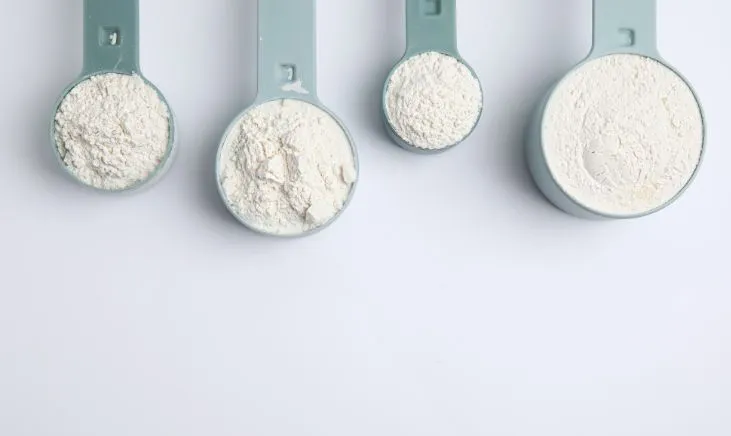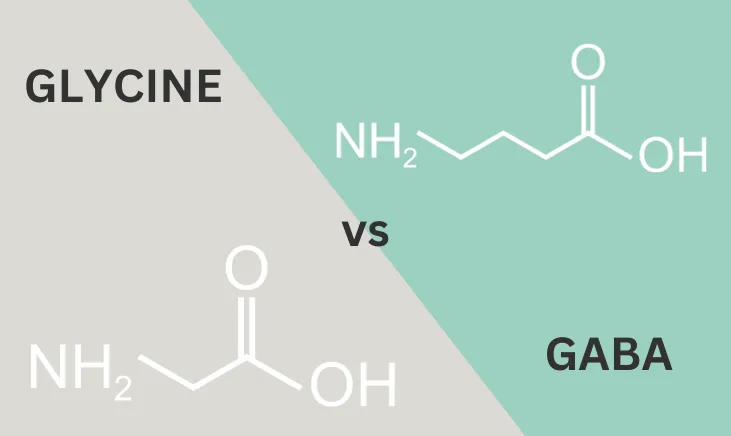GABA (γ-aminobutyric acid) and glycine are two major amino acid neurotransmitters in the central nervous system (CNS). Inhibitory neurons in the nervous system use either compound, but glycine tends to be more localized than GABA. Besides calming effects, glycine and GABA may also help with insomnia, stress/fatigue, improving cognitive performance, and more.
Quick look:
- GABA is a major inhibitory neurotransmitter formed from the precursor amino acid glutamate.
- Glycine is another major inhibitory neurotransmitter produced from choline, serine, hydroxyproline, and threonine.
- Glycine and GABA offer calming effects for the CNS, along with benefits for sleep, anxiety, digestion, joint health, and more.
- GABA and glycine are generally considered safe supplements when taken together or separately.
- GABA is found in several plant-based foods, while glycine is found in foods like bone broth and meat.
Table of Contents
What is GABA?

Gamma-aminobutyric acid (γ-aminobutyric acid), more commonly known as GABA, is an inhibitory neurotransmitter—an essential chemical messenger—within the CNS (brain and spinal cord). GABA synthesis occurs from the precursor amino acid glutamate, catalyzed by pyridoxal 5′ phosphate (PLP), the active form of vitamin B6, and the enzyme glutamate decarboxylase (GAD).
GABA Helps Calm the Nervous System
There are two classes of neurotransmitters: excitatory and inhibitory.
- Excitatory neurotransmitters: Promote the generation of action potentials and increase activity of the nervous system.
- Inhibitory neurotransmitters: Prevent the transmission of action potentials and reduce nervous system activity.
GABA is classified as one of the most important inhibitory neurotransmitters in the human body.
So, what does that mean? GABA functions to reduce the activity of the nervous system. GABA is released into the postsynaptic terminals or neurons to bind with GABA receptors and block the action of other compounds (i.e., reduce the effects of excitatory chemicals).
Simply put, if you’re feeling extra anxious or nervous, increasing circulating levels of GABA might take the edge off.
One of the primary roles of GABA is to reduce nerve excitability, which could contribute to anxiety and fear. Because it has a calming effect on the nervous system, it’s used as a natural remedy for anxiety.
A study published in the American Journal of Psychiatry found that people with panic disorder exhibit GABA responses. A similar study conducted by Columbia University College of Physicians and Surgeons’ Department of Psychiatry found that people with panic disorder and a family history of mood and anxiety disorders showed lower brain levels of GABA.
Although we can’t say for sure that mood disorders are directly linked to low levels of GABA, increasing circulating levels of the neurotransmitter may improve symptoms.
Taking GABA Supplements Can Help a Variety of Conditions
Apart from eliciting a calming effect, GABA might also offer other benefits for:
PMS
Every woman knows that PMS symptoms suck. Whether you’re dealing with cramps, back pain, or nausea, nothing about it is pleasant. While popping Advil might do the trick for some people, studies show that GABA may offer benefits too.
Interestingly, research finds that GABA levels are interrupted by menstruation and may decrease across the menstrual cycle. Increasing circulating levels of GABA could provide relief from symptoms.
How? Some studies suggest that GABA may act as a natural pain reliever, while others suggest it could be involved in the mechanism of menstrual cramps.
Insomnia
If you’ve ever tried to sleep only to find yourself staring at the ceiling for hours on end, you’ve experienced the mind-numbing effects of insomnia firsthand. And while other remedies can reduce symptoms and promote sleep, GABA might be a good one to try.
Thanks to its sedative effects, taking GABA before bed might help to naturally induce sleep by reducing nervous system excitability and promoting calmness. A 2015 study published in the Journal of Nutritional Science and Vitaminology found that taking a GABA supplement helped participants fall asleep quickly and shortened sleep onset latency by an average of five minutes.
But here’s the thing: people with insomnia likely have lower levels of GABA to begin with. A 2008 study published in the journal Sleep found that GABA levels were a whopping 30% lower in people with insomnia compared to those without.
Stress and Fatigue
Stress and fatigue happen, but how you handle them can make or break your health. Apart from the plethora of stress-relief techniques, GABA might be one to add to your anti-stress regimen. A 2011 Japanese study looked at the effects of GABA—taken in 25 or 50mg doses—on occupational fatigue relief and found that both doses led to reduced measures of mental and physical fatigue. Still, the higher dose appeared to be slightly more effective.
Growth Hormone Levels
Maximizing athletic performance is a goal of many. While there’s no shortage of supplements designed to boost muscle growth, GABA generally isn’t one you think about—but studies show that maybe you should.
Human growth hormone (hGH) is a hormone produced by the pituitary gland that’s important for strength, body composition, bone health, and more. Interestingly, studies show that supplementing with GABA may increase hGH levels. A 2008 study published in Medicine and Science in Sports and Exercise found that supplementing with 3g of GABA saw a 400% increase in hGH levels compared to people taking a placebo.
GABA Supplement Side Effects
Before starting any supplement or medication, it’s important to know about potential side effects. GABA is considered safe, and most people taking GABA don’t experience side effects, but that’s not to say that amino acids are free from side effects.

Potential side effects of GABA supplements include:
- Upset stomach/nausea
- Headache
- Fatigue/sleepiness
- Muscle weakness
It’s also not clear whether GABA interacts with certain medications, so people taking prescriptions for anxiety, depression, or insomnia should avoid taking GABA. Pregnant or breastfeeding women should also avoid taking GABA, as its effects aren’t known.
GABA Dosing
So, how much GABA is needed to reap benefits? Dosing may vary based on the effects you’re after and your individual composition, but in general, here are recommended doses for specific outcomes:
- Stress relief: 750-800 mg daily divided into three to four doses
- Anxiety: 250-650 mg 3x daily
- ADHD: 250-400 mg 3x daily
Before taking GABA, consult with your healthcare professional to ensure you’re taking the appropriate dosage and to avoid any adverse reactions or negative side effects.
What is Glycine?
We also have glycine in the same inhibitory neurotransmitter category that GABA sits in. But unlike GABA, glycine doesn’t only exert calming effects. Glycine is involved in various muscle, cognitive, and metabolic functions.
You’ll find high glycine concentrations in the skin, connective tissues, and muscles. As one of the most prominent amino acids used to form collagen and gelatin, it’s also plentiful in bone broth and certain types of meat.
But what exactly is glycine?
Glycine is classified as a conditionally essential amino acid, meaning the body can naturally produce it in small quantities from existing amino acids, but larger quantities must come from external sources (food or supplementation). It’s also one of the most widespread amino acids in human enzymes and proteins, so it shouldn’t come as a surprise that it’s involved in nearly every function in the body.
Some of the most notable roles of glycine include:
- Boosts lean muscle mass
- Prevents sarcopenia
- Supports the production of hGH
- Heals GI tract
- Protects cartilage and joints
- Reduces inflammation and enhances the production of glutathione
Among these benefits, there are some that are more well-studied than others.
Taking Glycine Supplements Can Help a Variety of Conditions
Apart from eliciting a relaxing effect, glycine might also offer other benefits for:
Muscle Growth
To avoid muscle degradation, add some glycine (or bone broth) to your diet. Studies have shown that glycine can protect against muscle loss by inhibiting the deterioration of protein tissue that forms muscle.
Thanks to its ability to promote hGH secretion, protect cartilage and prevent joint deterioration, and enhance physical performance, it’s sometimes called the “anti-aging amino acid.” On top of that, glycine is also a component of creatine biosynthesis, which is vital for muscle fuel and growth.
Protects Joints and Cartilage
Along with other amino acids in bone growth, glycine plays an important role in collagen synthesis—one of the most abundant proteins in the human body that’s integral for structural health and support.
Collagen is essential for maintaining the strength and integrity of connective tissues that keep your joints healthy and mobile, and roughly a third of collagen is composed of glycine. So, if you’ve ever wondered why collagen is prescribed for people with degenerative joint conditions, this is why.
However, because joint health decreases with age, increasing your intake of amino acids to maintain healthy tissues and joints becomes increasingly important.
Supports Antioxidant Production
For the body to produce the master antioxidant, glutathione (GSH), it needs glycine—one of three amino acids involved in its production. As one of the most powerful antioxidants in the body, glutathione protects cells against oxidative damage and chronic diseases that involve oxidative stress.
Insufficient glycine levels mean lower levels of GSH, which could interfere with managing levels of oxidative stress.
On top of that, glutathione levels typically decrease with age, so it’s important to increase your glycine intake to ensure sufficient production.
Energy
Glycine is one of the three amino acids—along with methionine and arginine—required to produce creatine. Because of this role, glycine is an important component in cellular energy production, including in the brain. Creatine can serve as a short-term energy source for neurons. The brain has high energy demands, so increasing glycine intake may increase creatine production and provide a quick energy source for the brain, thus enhancing brain function.
Sleep
Glycine is just one of many supplements that can support sleep. Although research is relatively limited to support this notion, some studies suggest that glycine can promote better sleep in the following ways:
- Reduce body temperature: Body temperature naturally decreases during sleep, and rodent studies show that glycine can reduce core body temperature—and continue to decrease it for about two hours after falling asleep.
- Boost serotonin: Serotonin might be your happy hormone, but it’s also the precursor to melatonin, your sleepy hormone. Studies suggest that the administration of glycine might increase brain serotonin levels, helping to improve sleep and combat insomnia.
Glycine Side Effects

Most people don’t take glycine supplements by themselves because it’s abundant in food sources, but it’s important to understand that, as with any supplement, there may be side effects.
These include:
- Nausea
- Vomiting
- Upset stomach
- Drowsiness
As a natural amino acid, the risk of overconsuming through diet is low, but higher doses—15 to 60 grams—have yielded positive results for specific conditions. That said, always consult with a health professional before taking high doses of glycine.
Some populations should also avoid glycine:
- Pregnant/breastfeeding women
- People taking certain medications, such as mental disorder meds
Long story short—food sources of glycine are the safest route if you’re looking to reap the benefits.
Glycine Dosing

The human body needs about 2 grams of glycine for optimal function, which should be supplied through diet. That said, if you’re taking supplements with glycine, you’ll want to ensure you get the correct dose.
Human studies have shown that 3 grams of glycine can improve sleep without causing side effects, but some studies have shown doses as high as 31 grams may be effective for certain conditions, equating to roughly 0.8g/kg of body weight.
Note: Although glycine is typically considered safe, excessive intake of specific amino acids can be toxic, so it’s important to speak with your healthcare provider to determine the correct dosing.
Glycine vs GABA: What’s the Difference?
As inhibitory amino acid neurotransmitters, both glycine and GABA have some overlap, but their primary jobs differ.
Check out the chart below for a breakdown of these two amino acids.
| Glycine | GABA | |
| Target tissue | CNS | CNS |
| Precursor compounds | Choline Serine Hydroxyproline Threonine | Glutamate |
| Function(s) | Inhibits transmission of nerve impulse/action potential Antioxidant Anti-inflammatory Cryoprotective Immunomodulatory | Inhibits transmission of nerve impulse/action potential |
| Benefits | Serotonin production Collagen formation Nerve signal transmission Creatine production Sleep Muscle maintenance | Anti-anxiety/stress Blood pressure Depression Sleep |
| Suggested dose | 2 to 5g | 50 to 3,000mg (no more than 750mg per dose) |
Key takeaway: GABA and glycine are both inhibitory neurotransmitters in the central nervous system that act on receptors coupled to chloride channels, but they each have unique health benefits.
Can I Take Glycine and GABA Together?
Yes—most research indicates that combining GABA and glycine supplementation is safe. In fact, taking both supplements together offers complementary benefits, including:
- Better digestion
- Healthier skin
- Less inflammation
- Lower anxiety and stress levels
- Better mood
- More Relaxation
Food Sources for GABA and Glycine

Although both GABA and glycine are widely available in supplement form, it’s also easy to boost levels through diet.
Here’s a breakdown of where you can find both amino acids:
| GABA | Glycine |
| Cruciferous vegetables Soybeans Adzuki beans Mushrooms Spinach (raw) Tomatoes Buckwheat Peas Chestnuts Sweet potatoes Sprouted grains Brown rice White tea | Gelatin/collagen Bone broth Poultry (especially skin) Seafood Meat Legumes Dairy Seaweed |
Frequently Asked Questions
Which is better, GABA or glycine?
There’s no right answer—whether GABA or glycine is better depends on the benefits you’re after. For relaxation, GABA might be the better option; for sleep and muscle growth, glycine has shown more benefits.
What is the action of glycine and GABA?
Glycine and GABA are both inhibitory neurotransmitters that act on receptors coupled to chloride channels to block the transmission of nerve impulses. In doing so, they can reduce nervous system activity and promote relaxation and calmness.
What does glycine do for the brain?
Glycine has several functions in the body. Its primary role is as an inhibitory neurotransmitter in the CNS, but it also regulates immune function, production of superoxide, and cytokine synthesis.
What does glycine do as a neurotransmitter?
As an inhibitory neurotransmitter, glycine is involved in processing motor and sensory information that allows for movement, vision, and audition.
Is it safe to take glycine and GABA together?
Most studies suggest that you can take glycine and GABA together with few side effects. Taken together or separately, GABA and glycine offer benefits for sleep, anxiety, stress, and more.
Is GABA or glycine better for sleep?
Both GABA and glycine offer several benefits for sleep. As an inhibitory neurotransmitter, GABA has been shown to slow down brain activity, thereby supporting sleep, while studies show that oral glycine consumption can increase serotonin (melatonin), reduce insomnia symptoms, and improve overall sleep quality.














